The Cambridge History of Japan, Vol. 4: Early Modern Japan
Подождите немного. Документ загружается.

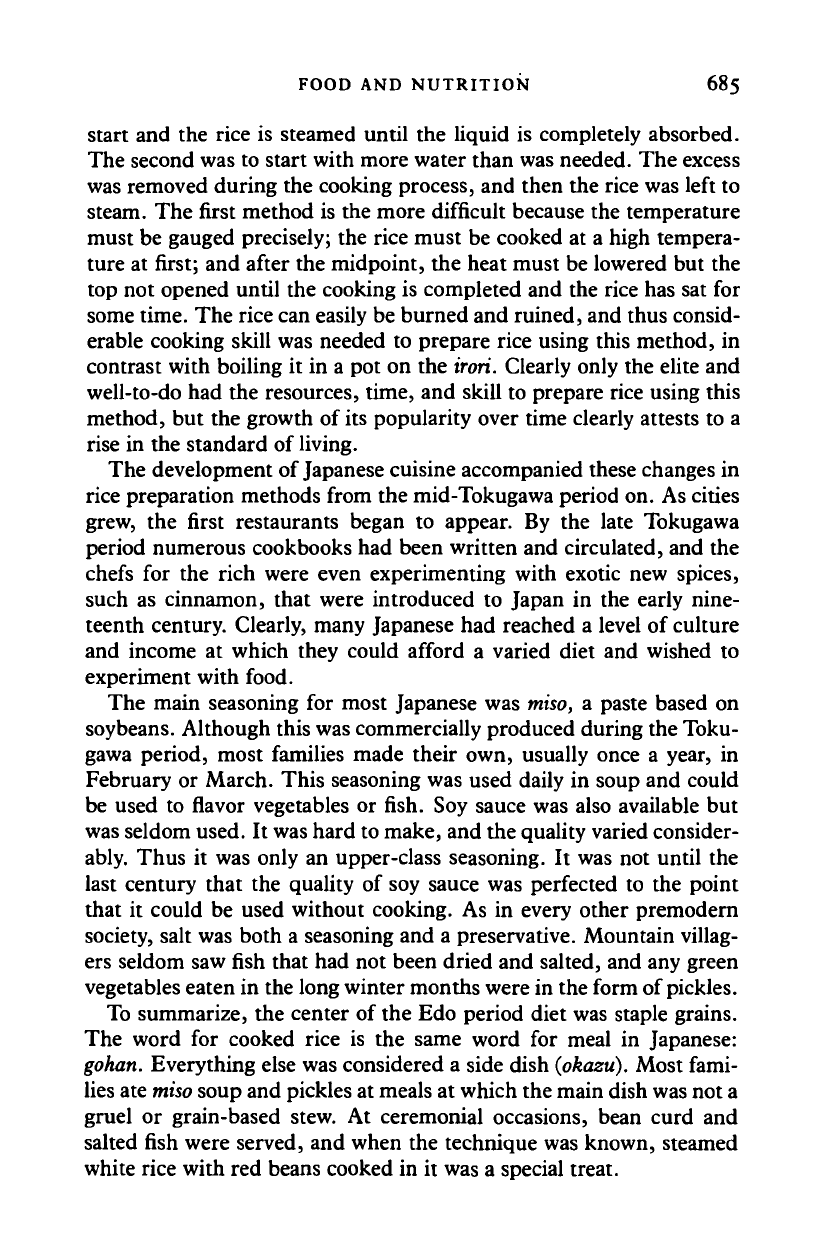
FOOD AND NUTRITION 685
start and the rice is steamed until the liquid is completely absorbed.
The second was to start with more water than was needed. The excess
was removed during the cooking process, and then the rice was left to
steam. The first method is the more difficult because the temperature
must be gauged precisely; the rice must be cooked at a high tempera-
ture at first; and after the midpoint, the heat must be lowered but the
top not opened until the cooking is completed and the rice has sat for
some time. The rice can easily be burned and ruined, and thus consid-
erable cooking skill was needed to prepare rice using this method, in
contrast with boiling it in a pot on the
iron.
Clearly only the elite and
well-to-do had the resources, time, and skill to prepare rice using this
method, but the growth of its popularity over time clearly attests to a
rise in the standard of living.
The development of Japanese cuisine accompanied these changes in
rice preparation methods from the mid-Tokugawa period on. As cities
grew, the first restaurants began to appear. By the late Tokugawa
period numerous cookbooks had been written and circulated, and the
chefs for the rich were even experimenting with exotic new spices,
such as cinnamon, that were introduced to Japan in the early nine-
teenth century. Clearly, many Japanese had reached a level of culture
and income at which they could afford a varied diet and wished to
experiment with food.
The main seasoning for most Japanese was
miso,
a paste based on
soybeans. Although this was commercially produced during the Toku-
gawa period, most families made their own, usually once a year, in
February or March. This seasoning was used daily in soup and could
be used to flavor vegetables or fish. Soy sauce was also available but
was seldom used. It was hard to make, and the quality varied consider-
ably. Thus it was only an upper-class seasoning. It was not until the
last century that the quality of soy sauce was perfected to the point
that it could be used without cooking. As in every other premodern
society, salt was both a seasoning and a preservative. Mountain villag-
ers seldom saw fish that had not been dried and salted, and any green
vegetables eaten in the long winter months were in the form of pickles.
To summarize, the center of the Edo period diet was staple grains.
The word for cooked rice is the same word for meal in Japanese:
gohan.
Everything else was considered a side dish
(okazu).
Most fami-
lies ate
miso
soup and pickles at meals at which the main dish was not a
gruel or grain-based stew. At ceremonial occasions, bean curd and
salted fish were served, and when the technique was known, steamed
white rice with red beans cooked in it was a special treat.
Cambridge Histories Online © Cambridge University Press, 2008
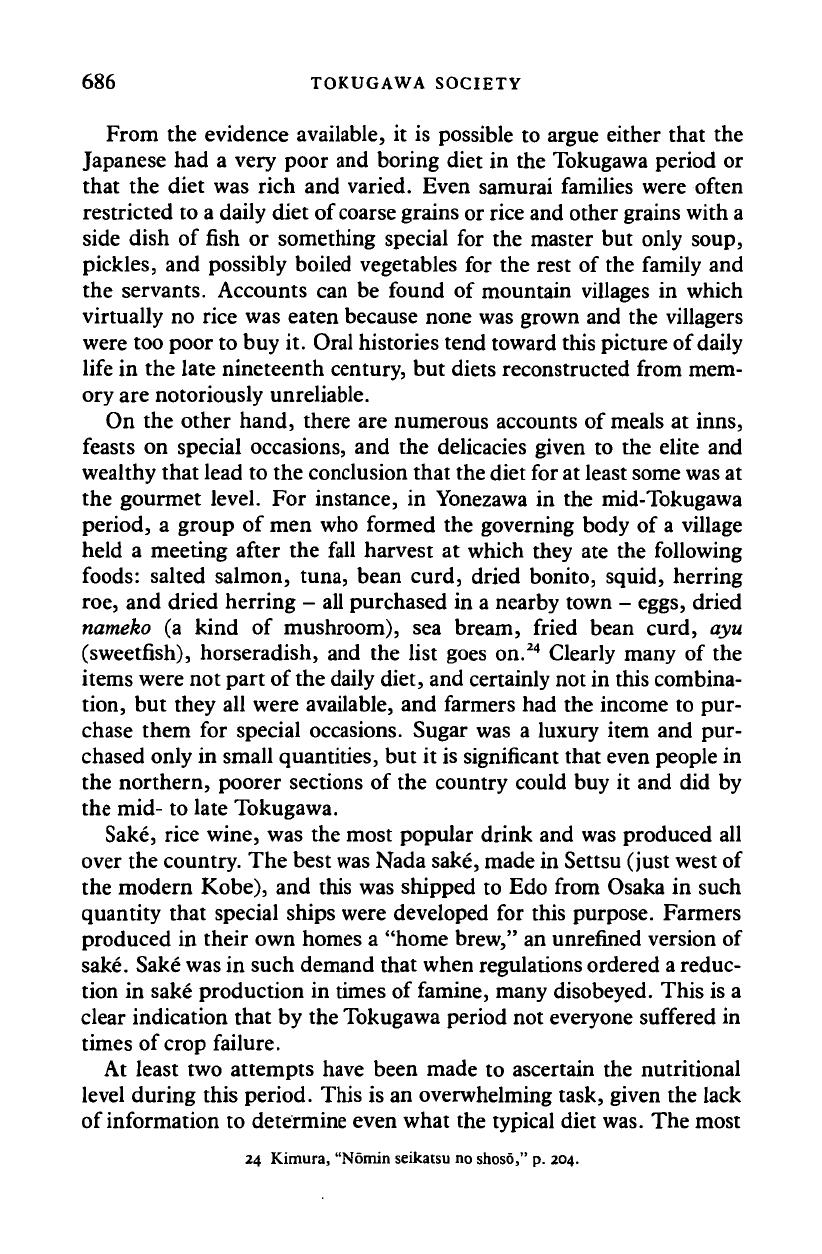
686 TOKUGAWA SOCIETY
From the evidence available, it is possible to argue either that the
Japanese had a very poor and boring diet in the Tokugawa period or
that the diet was rich and varied. Even samurai families were often
restricted to a daily diet of
coarse
grains or rice and other grains with a
side dish of fish or something special for the master but only soup,
pickles, and possibly boiled vegetables for the rest of the family and
the servants. Accounts can be found of mountain villages in which
virtually no rice was eaten because none was grown and the villagers
were too poor to buy it. Oral histories tend toward this picture of daily
life in the late nineteenth century, but diets reconstructed from mem-
ory are notoriously unreliable.
On the other hand, there are numerous accounts of meals at inns,
feasts on special occasions, and the delicacies given to the elite and
wealthy that lead to the conclusion that the diet for at least some was at
the gourmet level. For instance, in Yonezawa in the mid-Tokugawa
period, a group of men who formed the governing body of a village
held a meeting after the fall harvest at which they ate the following
foods:
salted salmon, tuna, bean curd, dried bonito, squid, herring
roe,
and dried herring - all purchased in a nearby town - eggs, dried
nameko (a kind of mushroom), sea bream, fried bean curd, ayu
(sweetfish), horseradish, and the list goes on.
24
Clearly many of the
items were not part of the daily diet, and certainly not in this combina-
tion, but they all were available, and farmers had the income to pur-
chase them for special occasions. Sugar was a luxury item and pur-
chased only in small quantities, but it is significant that even people in
the northern, poorer sections of the country could buy it and did by
the mid- to late Tokugawa.
Sake, rice wine, was the most popular drink and was produced all
over the country. The best
was
Nada sake, made in Settsu (just west of
the modern Kobe), and this was shipped to Edo from Osaka in such
quantity that special ships were developed for this purpose. Farmers
produced in their own homes a "home brew," an unrefined version of
sake.
Sake was in such demand that when regulations ordered a reduc-
tion in sake production in times of famine, many disobeyed. This is a
clear indication that by the Tokugawa period not everyone suffered in
times of crop failure.
At least two attempts have been made to ascertain the nutritional
level during this period. This is an overwhelming task, given the lack
of information to determine even what the typical diet was. The most
24 Kimura, "Nomin seikatsu no shoso," p. 204.
Cambridge Histories Online © Cambridge University Press, 2008
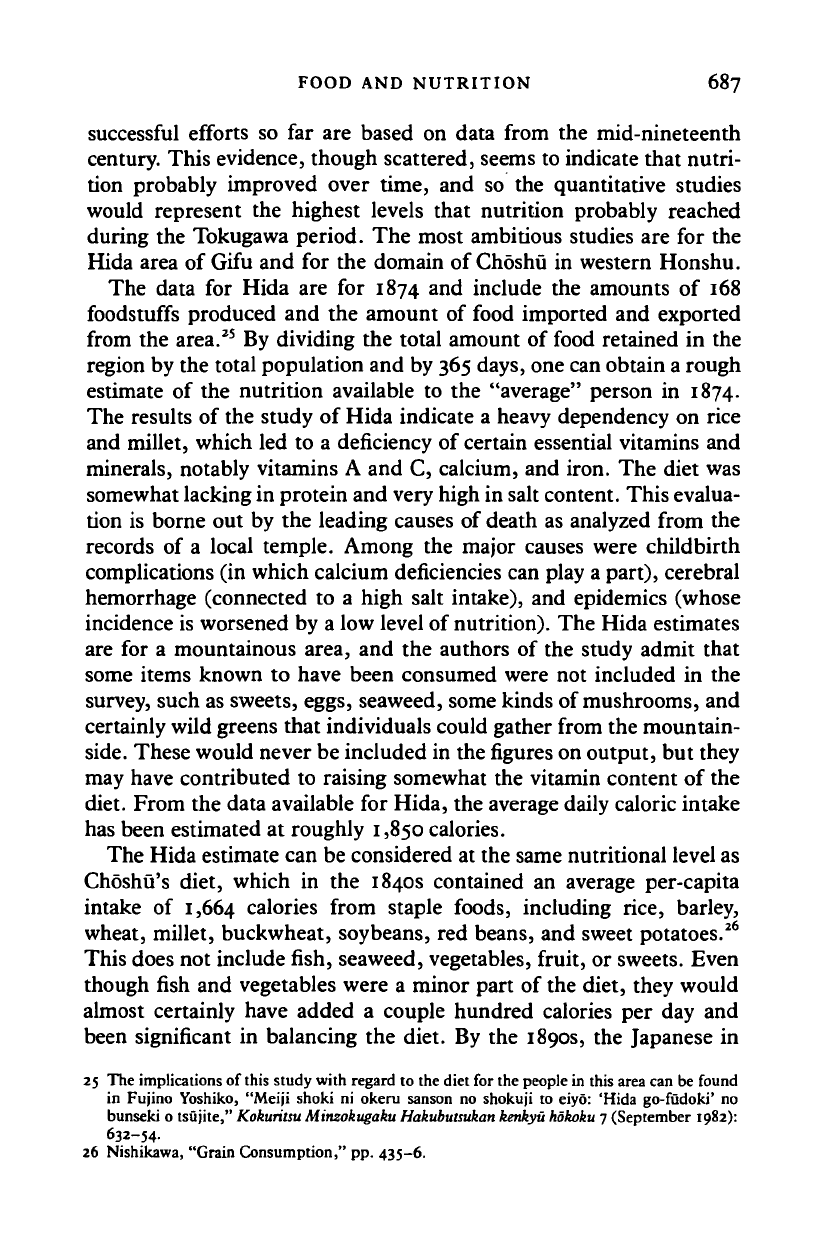
FOOD AND NUTRITION 687
successful efforts so far are based on data from the mid-nineteenth
century. This evidence, though scattered, seems to indicate that nutri-
tion probably improved over time, and so the quantitative studies
would represent the highest levels that nutrition probably reached
during the Tokugawa period. The most ambitious studies are for the
Hida area of Gifu and for the domain of Choshu in western Honshu.
The data for Hida are for 1874 and include the amounts of 168
foodstuffs produced and the amount of food imported and exported
from the area.
25
By dividing the total amount of food retained in the
region by the total population and by 365 days, one can obtain a rough
estimate of the nutrition available to the "average" person in 1874.
The results of the study of Hida indicate a heavy dependency on rice
and millet, which led to a deficiency of certain essential vitamins and
minerals, notably vitamins A and C, calcium, and iron. The diet was
somewhat lacking in protein and very high in salt content. This evalua-
tion is borne out by the leading causes of death as analyzed from the
records of a local temple. Among the major causes were childbirth
complications (in which calcium deficiencies can play a part), cerebral
hemorrhage (connected to a high salt intake), and epidemics (whose
incidence is worsened by a low level of
nutrition).
The Hida estimates
are for a mountainous area, and the authors of the study admit that
some items known to have been consumed were not included in the
survey, such as sweets, eggs, seaweed, some kinds of mushrooms, and
certainly wild greens that individuals could gather from the mountain-
side.
These would never be included in the
figures
on output, but they
may have contributed to raising somewhat the vitamin content of the
diet. From the data available for Hida, the average daily caloric intake
has been estimated at roughly 1,850 calories.
The Hida estimate can be considered at the same nutritional level as
Choshu's diet, which in the 1840s contained an average per-capita
intake of 1,664 calories from staple foods, including rice, barley,
wheat, millet, buckwheat, soybeans, red beans, and sweet potatoes.
26
This does not include fish, seaweed, vegetables, fruit, or sweets. Even
though fish and vegetables were a minor part of the diet, they would
almost certainly have added a couple hundred calories per day and
been significant in balancing the diet. By the 1890s, the Japanese in
25 The implications of this study with regard to the diet for the people in this area can be found
in Fujino Yoshiko, "Meiji shoki ni okeru sanson no shokuji to eiyo: 'Hida go-fudoki' no
bunseki o tsujite," Kokuritsu Minzokugaku
Hakubuisukan kenkyu hokoku
7 (September 1982):
632-54-
26 Nishikawa, "Grain Consumption," pp. 435-6.
Cambridge Histories Online © Cambridge University Press, 2008
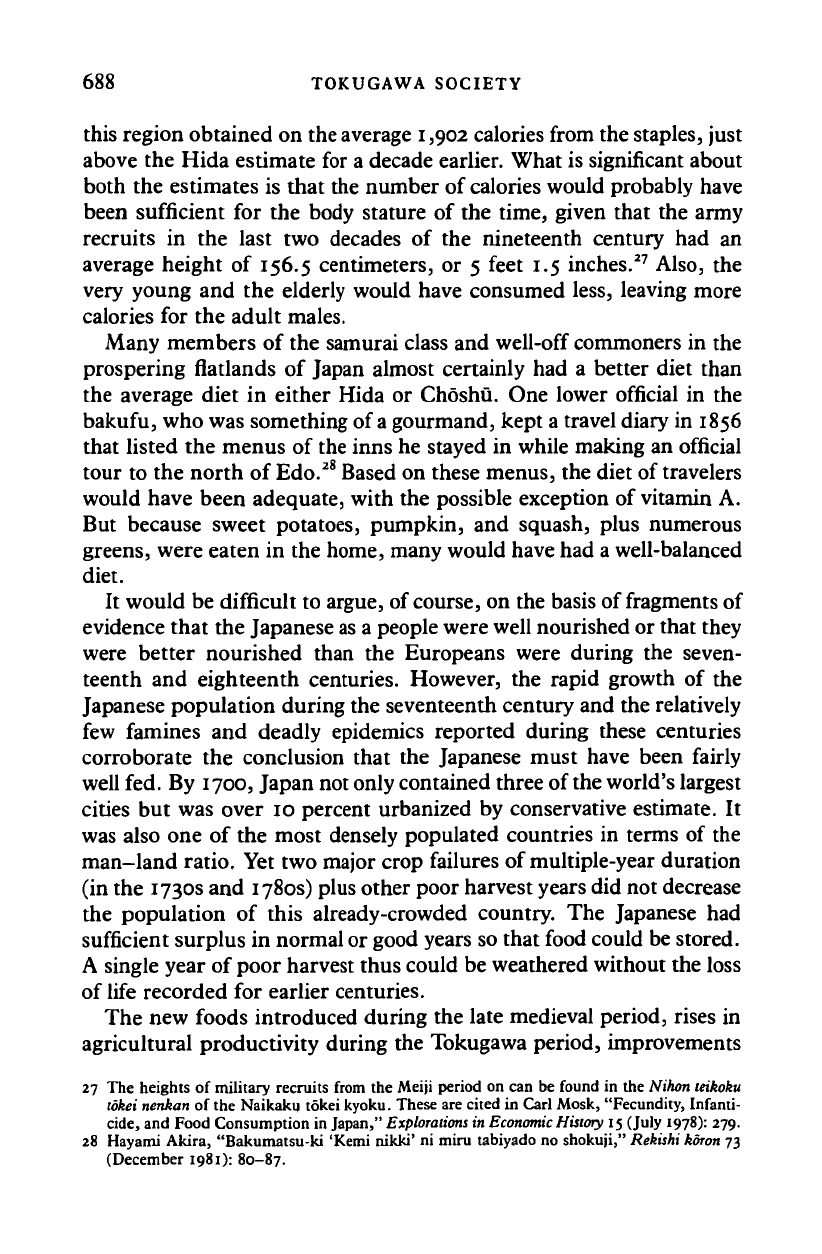
688 TOKUGAWA SOCIETY
this region obtained on the average
i ,902
calories from the staples, just
above the Hida estimate for a decade earlier. What is significant about
both the estimates is that the number of calories would probably have
been sufficient for the body stature of the time, given that the army
recruits in the last two decades of the nineteenth century had an
average height of 156.5 centimeters, or 5 feet 1.5 inches.
27
Also, the
very young and the elderly would have consumed less, leaving more
calories for the adult males.
Many members of the samurai class and well-off commoners in the
prospering flatlands of Japan almost certainly had a better diet than
the average diet in either Hida or Choshu. One lower official in the
bakufu, who was something of a gourmand, kept a travel diary in 1856
that listed the menus of the inns he stayed in while making an official
tour to the north of
Edo.
28
Based on these menus, the diet of travelers
would have been adequate, with the possible exception of vitamin A.
But because sweet potatoes, pumpkin, and squash, plus numerous
greens, were eaten in the home, many would have had a well-balanced
diet.
It would be difficult to argue, of course, on the basis of fragments of
evidence that the Japanese
as
a people were well nourished or that they
were better nourished than the Europeans were during the seven-
teenth and eighteenth centuries. However, the rapid growth of the
Japanese population during the seventeenth century and the relatively
few famines and deadly epidemics reported during these centuries
corroborate the conclusion that the Japanese must have been fairly
well fed. By 1700, Japan not only contained three of the world's largest
cities but was over 10 percent urbanized by conservative estimate. It
was also one of the most densely populated countries in terms of the
man-land ratio. Yet two major crop failures of multiple-year duration
(in the 1730s and 1780s) plus other poor harvest years did not decrease
the population of this already-crowded country. The Japanese had
sufficient surplus in normal or good years so that food could be stored.
A single year of poor harvest thus could be weathered without the loss
of life recorded for earlier centuries.
The new foods introduced during the late medieval period, rises in
agricultural productivity during the Tokugawa period, improvements
27 The heights of military recruits from the Meiji period on can be found in the Nihon teikoku
tokei nenkan of the Naikaku tokei kyoku. These are cited in Carl Mosk, "Fecundity, Infanti-
cide, and Food Consumption in Japan,"
Explorations
in
Economic
History 15 (July 1978): 279.
28 Hayami Akira, "Bakumatsu-ki 'Kemi nikki' ni mini tabiyado no shokuji," Rekishi
koron
73
(December 1981): 80-87.
Cambridge Histories Online © Cambridge University Press, 2008
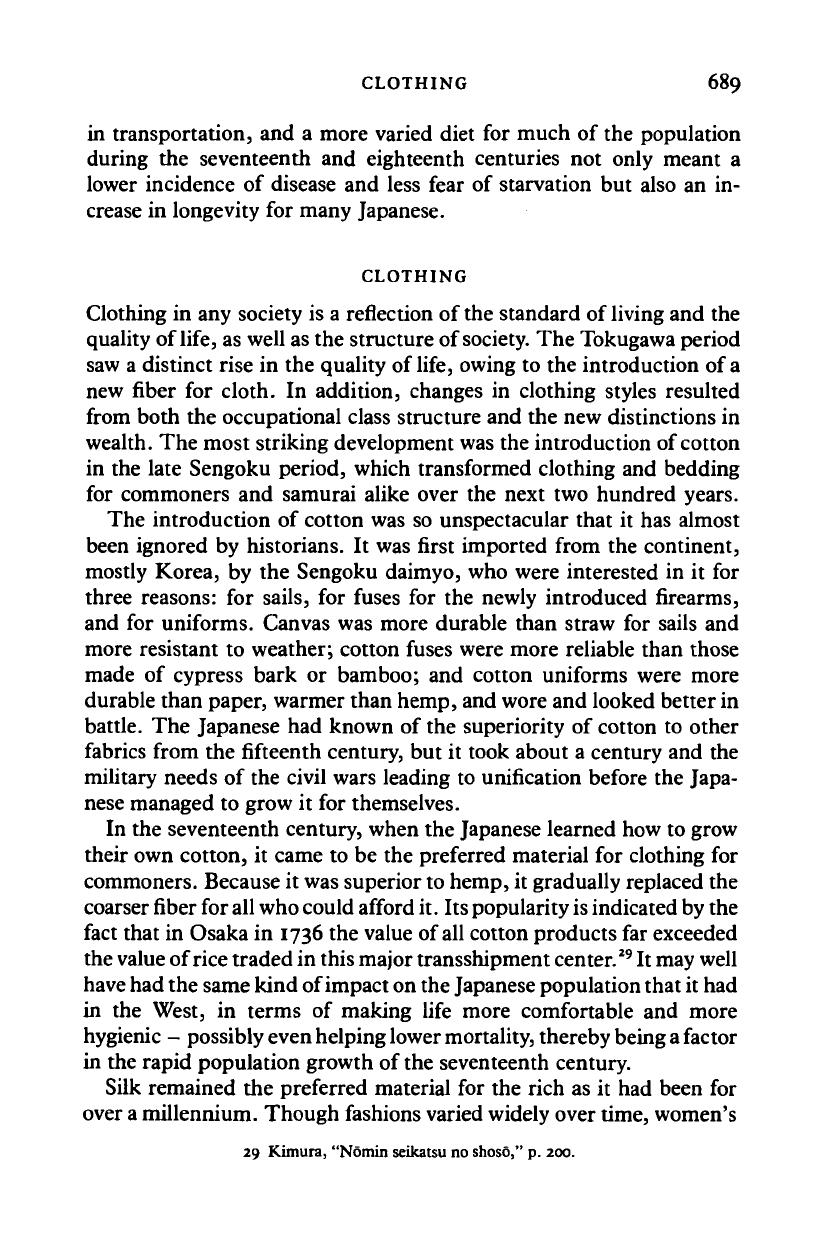
CLOTHING 689
in transportation, and a more varied diet for much of the population
during the seventeenth and eighteenth centuries not only meant a
lower incidence of disease and less fear of starvation but also an in-
crease in longevity for many Japanese.
CLOTHING
Clothing in any society is a reflection of the standard of living and the
quality of life, as well as the structure of society. The Tokugawa period
saw a distinct rise in the quality of
life,
owing to the introduction of
a
new fiber for cloth. In addition, changes in clothing styles resulted
from both the occupational class structure and the new distinctions in
wealth. The most striking development was the introduction of cotton
in the late Sengoku period, which transformed clothing and bedding
for commoners and samurai alike over the next two hundred years.
The introduction of cotton was so unspectacular that it has almost
been ignored by historians. It was first imported from the continent,
mostly Korea, by the Sengoku daimyo, who were interested in it for
three reasons: for sails, for fuses for the newly introduced firearms,
and for uniforms. Canvas was more durable than straw for sails and
more resistant to weather; cotton fuses were more reliable than those
made of cypress bark or bamboo; and cotton uniforms were more
durable than paper, warmer than hemp, and wore and looked better in
battle. The Japanese had known of the superiority of cotton to other
fabrics from the fifteenth century, but it took about a century and the
military needs of the civil wars leading to unification before the Japa-
nese managed to grow it for themselves.
In the seventeenth century, when the Japanese learned how to grow
their own cotton, it came to be the preferred material for clothing for
commoners. Because it was superior to hemp, it gradually replaced the
coarser
fiber
for
all
who could afford
it.
Its
popularity
is
indicated by the
fact that in Osaka in 1736 the value of all cotton products far exceeded
the value of rice traded in this major transshipment center.
29
It may well
have
had the same kind of impact on the Japanese population that it had
in the West, in terms of making life more comfortable and more
hygienic - possibly even helping lower mortality, thereby being a factor
in the rapid population growth of the seventeenth century.
Silk remained the preferred material for the rich as it had been for
over
a
millennium. Though fashions varied widely over time, women's
29 Kimura, "Nomin seikatsu no shoso," p. 200.
Cambridge Histories Online © Cambridge University Press, 2008
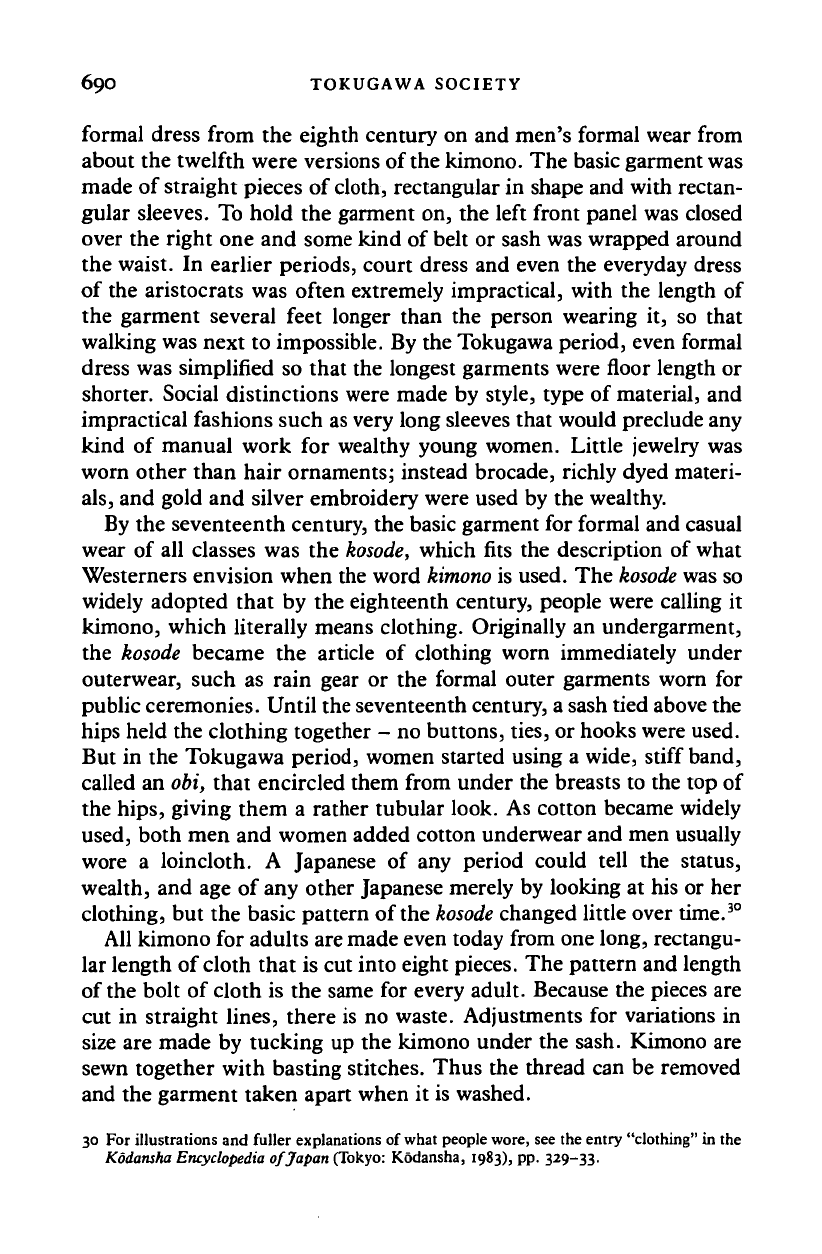
69O TOKUGAWA SOCIETY
formal dress from the eighth century on and men's formal wear from
about the twelfth were versions of the kimono. The basic garment was
made of straight pieces of cloth, rectangular in shape and with rectan-
gular sleeves. To hold the garment on, the left front panel was closed
over the right one and some kind of belt or sash was wrapped around
the waist. In earlier periods, court dress and even the everyday dress
of the aristocrats was often extremely impractical, with the length of
the garment several feet longer than the person wearing it, so that
walking was next to impossible. By the Tokugawa period, even formal
dress was simplified so that the longest garments were floor length or
shorter. Social distinctions were made by style, type of material, and
impractical fashions such as very long sleeves that would preclude any
kind of manual work for wealthy young women. Little jewelry was
worn other than hair ornaments; instead brocade, richly dyed materi-
als,
and gold and silver embroidery were used by the wealthy.
By the seventeenth century, the basic garment for formal and casual
wear of all classes was the
kosode,
which fits the description of what
Westerners envision when the word
kimono
is used. The
kosode
was so
widely adopted that by the eighteenth century, people were calling it
kimono, which literally means clothing. Originally an undergarment,
the
kosode
became the article of clothing worn immediately under
outerwear, such as rain gear or the formal outer garments worn for
public ceremonies. Until the seventeenth century, a sash tied above the
hips held the clothing together - no buttons, ties, or hooks were used.
But in the Tokugawa period, women started using a wide, stiff band,
called an obi, that encircled them from under the breasts to the top of
the hips, giving them a rather tubular look. As cotton became widely
used, both men and women added cotton underwear and men usually
wore a loincloth. A Japanese of any period could tell the status,
wealth, and age of any other Japanese merely by looking at his or her
clothing, but the basic pattern of the
kosode
changed little over time.
30
All kimono for adults are made even today from one long, rectangu-
lar length of cloth that is cut into eight pieces. The pattern and length
of the bolt of cloth is the same for every adult. Because the pieces are
cut in straight lines, there is no waste. Adjustments for variations in
size are made by tucking up the kimono under the sash. Kimono are
sewn together with basting stitches. Thus the thread can be removed
and the garment taken apart when it is washed.
30 For illustrations and fuller explanations of what people wore, see the entry "clothing" in the
Kodansha Encyclopedia
of Japan (Tokyo: Kodansha, 1983), pp. 329-33.
Cambridge Histories Online © Cambridge University Press, 2008
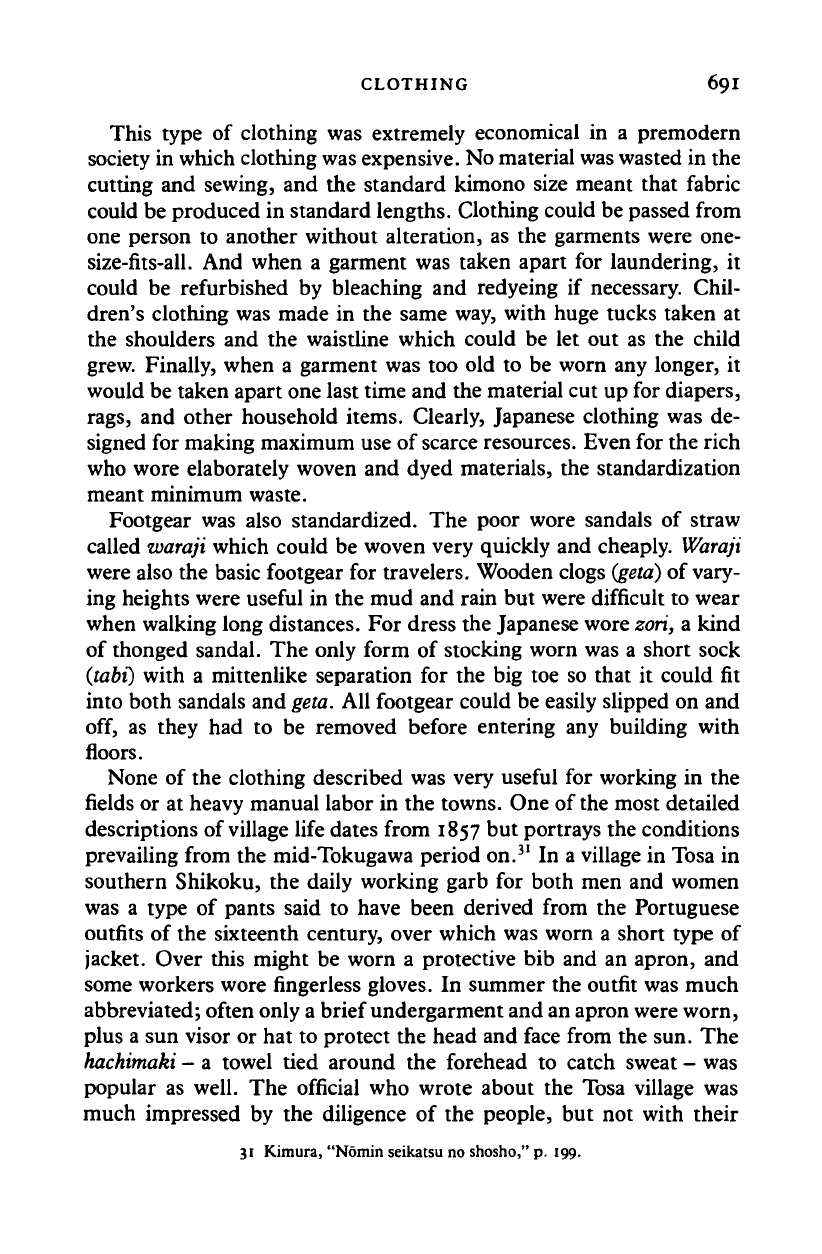
CLOTHING 69I
This type of clothing was extremely economical in a premodern
society in which clothing was expensive. No material was wasted in the
cutting and sewing, and the standard kimono size meant that fabric
could be produced in standard lengths. Clothing could be passed from
one person to another without alteration, as the garments were one-
size-fits-all. And when a garment was taken apart for laundering, it
could be refurbished by bleaching and redyeing if necessary. Chil-
dren's clothing was made in the same way, with huge tucks taken at
the shoulders and the waistline which could be let out as the child
grew. Finally, when a garment was too old to be worn any longer, it
would be taken apart one last time and the material cut up for diapers,
rags,
and other household items. Clearly, Japanese clothing was de-
signed for making maximum use of scarce resources. Even for the rich
who wore elaborately woven and dyed materials, the standardization
meant minimum waste.
Footgear was also standardized. The poor wore sandals of straw
called
waraji
which could be woven very quickly and cheaply. Waraji
were also the basic footgear for travelers. Wooden clogs
(geta)
of vary-
ing heights were useful in the mud and rain but were difficult to wear
when walking long distances. For dress the Japanese wore
zori,
a kind
of thonged sandal. The only form of stocking worn was a short sock
(tabi) with a mittenlike separation for the big toe so that it could fit
into both sandals and
geta.
All footgear could be easily slipped on and
off, as they had to be removed before entering any building with
floors.
None of the clothing described was very useful for working in the
fields or at heavy manual labor in the towns. One of the most detailed
descriptions of village life dates from 1857 but portrays the conditions
prevailing from the mid-Tokugawa period on.
31
In a village in Tosa in
southern Shikoku, the daily working garb for both men and women
was a type of pants said to have been derived from the Portuguese
outfits of the sixteenth century, over which was worn a short type of
jacket. Over this might be worn a protective bib and an apron, and
some workers wore fingerless gloves. In summer the outfit was much
abbreviated; often only a brief undergarment and an apron were worn,
plus a sun visor or hat to protect the head and face from the sun. The
hachimaki
- a towel tied around the forehead to catch sweat - was
popular as well. The official who wrote about the Tosa village was
much impressed by the diligence of the people, but not with their
31 Kimura, "Nomin seikatsu no shosho," p. 199.
Cambridge Histories Online © Cambridge University Press, 2008
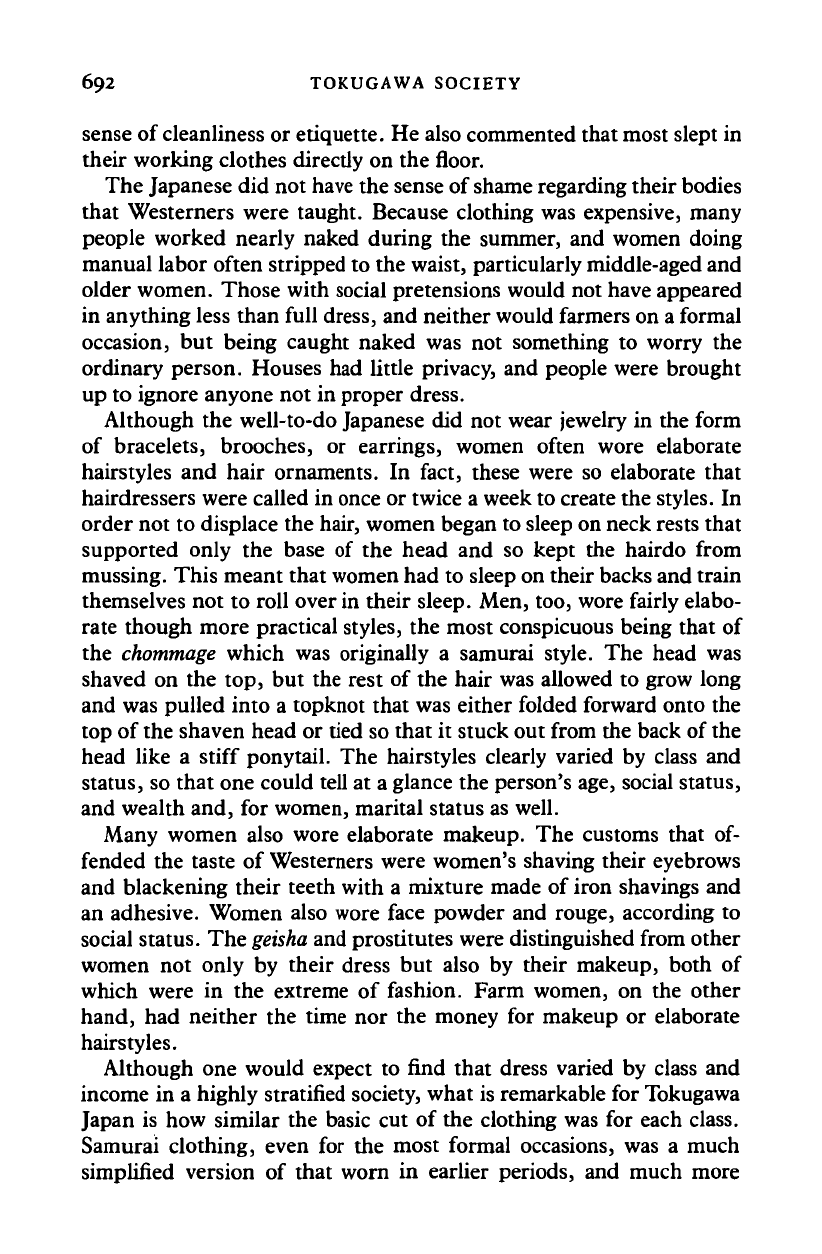
692 TOKUGAWA SOCIETY
sense of cleanliness or etiquette. He also commented that most slept in
their working clothes directly on the floor.
The Japanese did not have the sense of shame regarding their bodies
that Westerners were taught. Because clothing was expensive, many
people worked nearly naked during the summer, and women doing
manual labor often stripped to the waist, particularly middle-aged and
older women. Those with social pretensions would not have appeared
in anything less than full dress, and neither would farmers on a formal
occasion, but being caught naked was not something to worry the
ordinary person. Houses had little privacy, and people were brought
up to ignore anyone not in proper dress.
Although the well-to-do Japanese did not wear jewelry in the form
of bracelets, brooches, or earrings, women often wore elaborate
hairstyles and hair ornaments. In fact, these were so elaborate that
hairdressers were called in once or twice a week to create the styles. In
order not to displace the hair, women began to sleep on neck rests that
supported only the base of the head and so kept the hairdo from
mussing. This meant that women had to sleep on their backs and train
themselves not to roll over in their sleep. Men, too, wore fairly elabo-
rate though more practical styles, the most conspicuous being that of
the
chommage
which was originally a samurai style. The head was
shaved on the top, but the rest of the hair was allowed to grow long
and was pulled into a topknot that was either folded forward onto the
top of the shaven head or tied so that it stuck out from the back of the
head like a stiff pony
tail.
The hairstyles clearly varied by class and
status,
so that one could tell at a glance the person's age, social status,
and wealth and, for women, marital status as well.
Many women also wore elaborate makeup. The customs that of-
fended the taste of Westerners were women's shaving their eyebrows
and blackening their teeth with a mixture made of iron shavings and
an adhesive. Women also wore face powder and rouge, according to
social status. The
geisha
and prostitutes were distinguished from other
women not only by their dress but also by their makeup, both of
which were in the extreme of fashion. Farm women, on the other
hand, had neither the time nor the money for makeup or elaborate
hairstyles.
Although one would expect to find that dress varied by class and
income in a highly stratified society, what is remarkable for Tokugawa
Japan is how similar the basic cut of the clothing was for each class.
Samurai clothing, even for the most formal occasions, was a much
simplified version of that worn in earlier periods, and much more
Cambridge Histories Online © Cambridge University Press, 2008
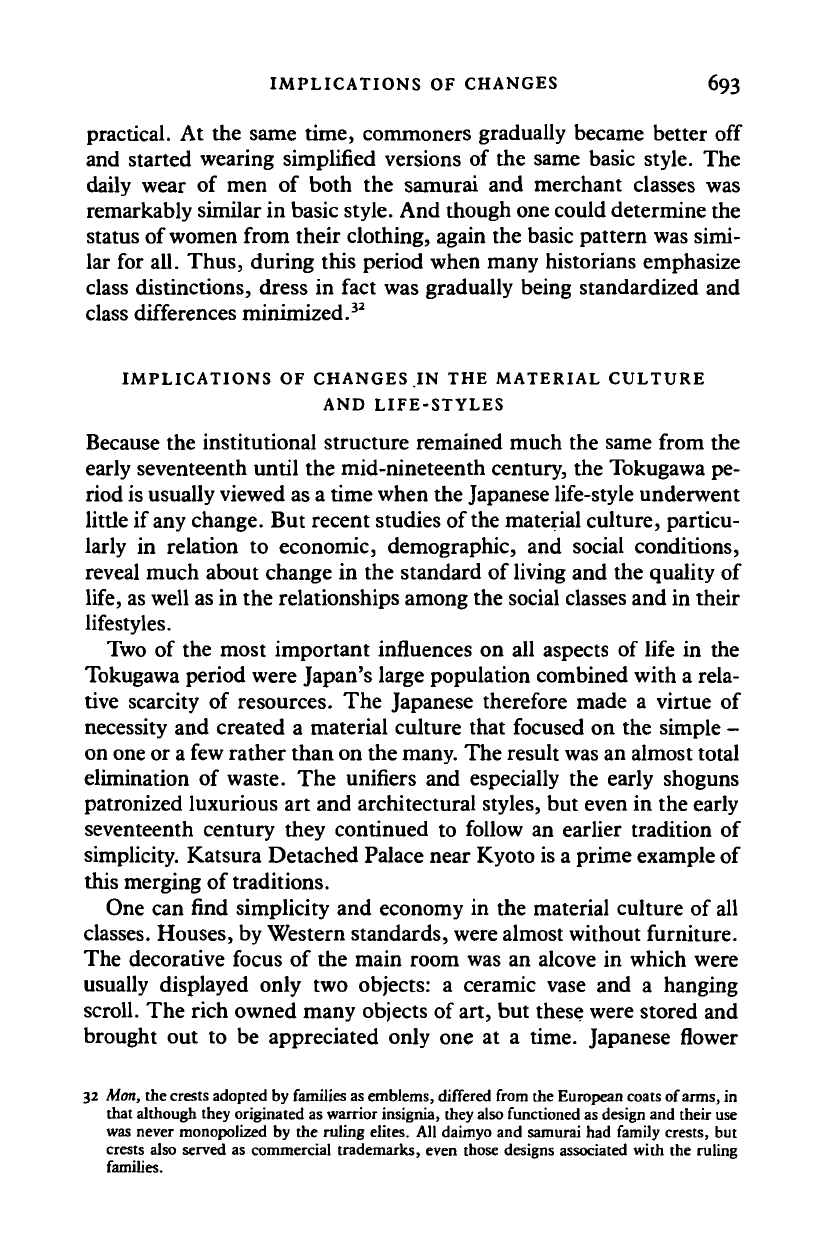
IMPLICATIONS OF CHANGES 693
practical. At the same time, commoners gradually became better off
and started wearing simplified versions of the same basic style. The
daily wear of men of both the samurai and merchant classes was
remarkably similar in basic style. And though one could determine the
status of women from their clothing, again the basic pattern was simi-
lar for all. Thus, during this period when many historians emphasize
class distinctions, dress in fact was gradually being standardized and
class differences minimized.
32
IMPLICATIONS OF CHANGES IN THE MATERIAL CULTURE
AND LIFE-STYLES
Because the institutional structure remained much the same from the
early seventeenth until the mid-nineteenth century, the Tokugawa pe-
riod is usually viewed as a time when the Japanese life-style underwent
little if any change. But recent studies of the material culture, particu-
larly in relation to economic, demographic, and social conditions,
reveal much about change in the standard of living and the quality of
life,
as well as in the relationships among the social classes and in their
lifestyles.
Two of the most important influences on all aspects of life in the
Tokugawa period were Japan's large population combined with a rela-
tive scarcity of resources. The Japanese therefore made a virtue of
necessity and created a material culture that focused on the simple -
on one or a few rather than on the many. The result was an almost total
elimination of waste. The unifiers and especially the early shoguns
patronized luxurious art and architectural styles, but even in the early
seventeenth century they continued to follow an earlier tradition of
simplicity. Katsura Detached Palace near Kyoto is a prime example of
this merging of traditions.
One can find simplicity and economy in the material culture of all
classes. Houses, by Western standards, were almost without furniture.
The decorative focus of the main room was an alcove in which were
usually displayed only two objects: a ceramic vase and a hanging
scroll. The rich owned many objects of an, but these were stored and
brought out to be appreciated only one at a time. Japanese flower
32 Mon, the crests adopted by families as emblems, differed from the European coats of
arms,
in
that although they originated as warrior insignia, they also functioned as design and their use
was never monopolized by the ruling elites. All daimyo and samurai had family crests, but
crests also served as commercial trademarks, even those designs associated with the ruling
families.
Cambridge Histories Online © Cambridge University Press, 2008
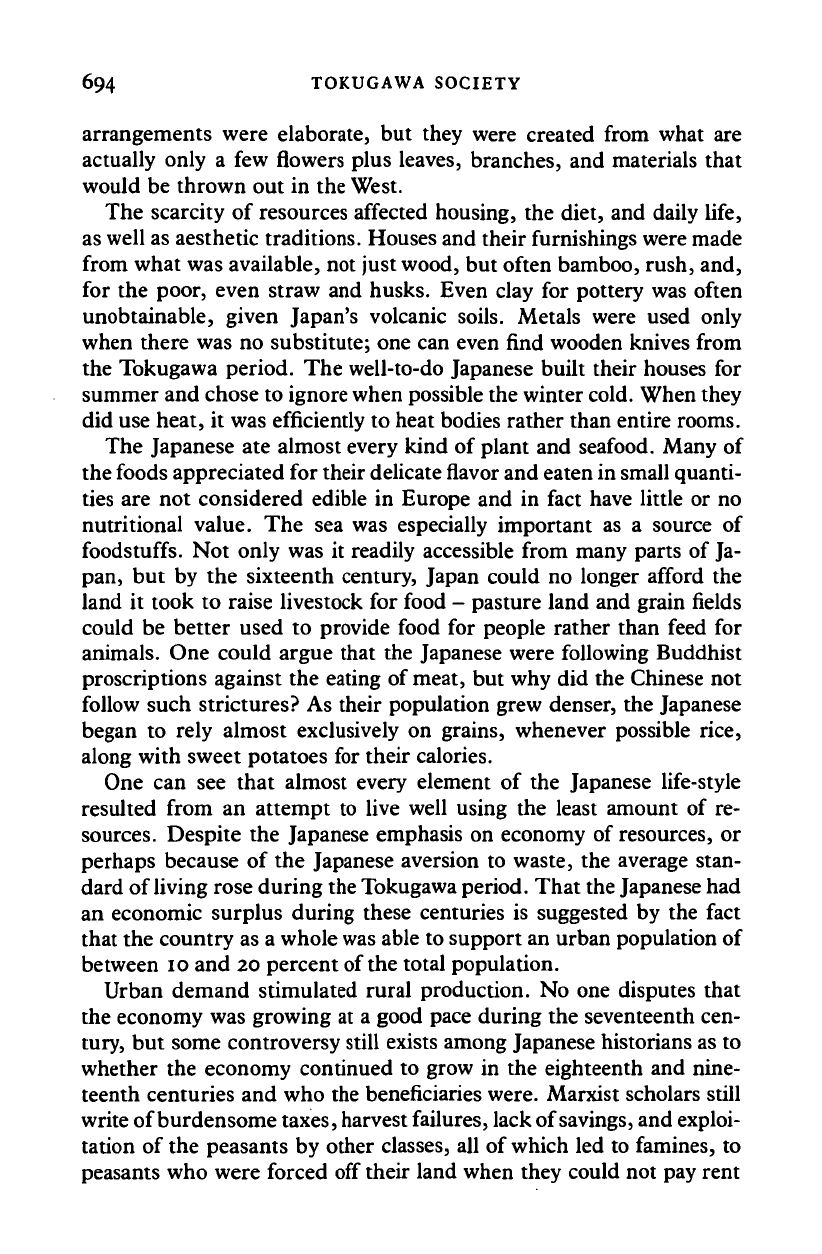
694 TOKUGAWA SOCIETY
arrangements were elaborate, but they were created from what are
actually only a few flowers plus leaves, branches, and materials that
would be thrown out in the West.
The scarcity of resources affected housing, the diet, and daily life,
as well as aesthetic traditions. Houses and their furnishings were made
from what was available, not just wood, but often bamboo, rush, and,
for the poor, even straw and husks. Even clay for pottery was often
unobtainable, given Japan's volcanic soils. Metals were used only
when there was no substitute; one can even find wooden knives from
the Tokugawa period. The well-to-do Japanese built their houses for
summer and chose to ignore when possible the winter cold. When they
did use heat, it was efficiently to heat bodies rather than entire rooms.
The Japanese ate almost every kind of plant and seafood. Many of
the foods appreciated for their delicate
flavor
and eaten in small quanti-
ties are not considered edible in Europe and in fact have little or no
nutritional value. The sea was especially important as a source of
foodstuffs. Not only was it readily accessible from many parts of Ja-
pan, but by the sixteenth century, Japan could no longer afford the
land it took to raise livestock for food - pasture land and grain fields
could be better used to provide food for people rather than feed for
animals. One could argue that the Japanese were following Buddhist
proscriptions against the eating of meat, but why did the Chinese not
follow such strictures? As their population grew denser, the Japanese
began to rely almost exclusively on grains, whenever possible rice,
along with sweet potatoes for their calories.
One can see that almost every element of the Japanese life-style
resulted from an attempt to live well using the least amount of re-
sources. Despite the Japanese emphasis on economy of resources, or
perhaps because of the Japanese aversion to waste, the average stan-
dard of living rose during the Tokugawa period. That the Japanese had
an economic surplus during these centuries is suggested by the fact
that the country as a whole
was
able to support an urban population of
between 10 and 20 percent of the total population.
Urban demand stimulated rural production. No one disputes that
the economy was growing at a good pace during the seventeenth cen-
tury, but some controversy still exists among Japanese historians as to
whether the economy continued to grow in the eighteenth and nine-
teenth centuries and who the beneficiaries were. Marxist scholars still
write of burdensome taxes, harvest failures, lack of savings, and exploi-
tation of the peasants by other classes, all of which led to famines, to
peasants who were forced off their land when they could not pay rent
Cambridge Histories Online © Cambridge University Press, 2008
